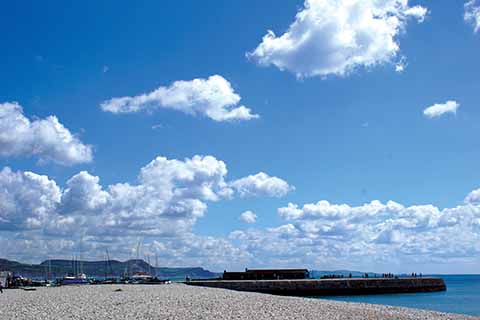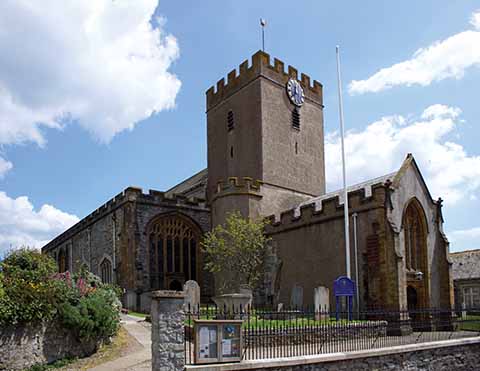Lyme Regis history walk
Harry Chesterfield goes for a two-mile, 200-million-year walk
Published in July ’19
Many places may claim to be steeped in history; Lyme Regis is built on it. It is, at least geologically, the oldest place in Dorset. The Blue Lias rock on which it sits was laid down 195-200 million years ago. At the other end of the Jurassic Coast in Dorset, the bedrock on which Dorset sits is 135 million years younger.
It is not just in terms of its geological history that makes Lyme worthy of a visit, though. The town is inextricably linked with the history of Dorset and of the wider country. It has strong associations with literary history, politics, war and, of course, the sea.
Trying to cram all of Lyme Regis’s history into a two-mile stroll around the town is a bit of a challenge, but not so much as it would be to try to do the walk in chronological order of its points of interest, so excuse the Tarantino-esque leaping about in the narrative timelines and decide for yourself if you think that this decision is worth it to make it a two-mile stroll rather than a ten-mile hike.
1 Start in the Car park on Hill Lane.
Turn right and make your way up Hill Road to Silver Street, where begin the long descent to the sea on Silver Street before turning right onto Pound Street, where we pause to look at…
2 The Alexandra Hotel.
Formerly known as Poullett House, this boutique hotel was built in 1735, likely as a dower house for the Countess Poullett, but was also where the future great ornithologist, John Gould, was brought up as the son of the head gardener there. Gould identified the birds now known as ‘Darwin’s finches’, which helped Darwin put into place his work on the origin of species. Flying of a different kind played a role in the history of the building when Sir Barnes Neville Wallis stayed at the hotel during the initial testing of bouncing bomb prototypes at Chesil Bank. Continue westwards along Pound Street until Cobb Road, at which junction we find…
3 Belmont
There are many literary associations with Lyme Regis, but none is stronger, perhaps, than that with John Fowles, whose novel (and later the film adaptation of) The French Lieutenant’s Woman made the Cobb and by extension Lyme Regis an international landmark. The house in which he wrote many of his novels is now a Landmark Trust property celebrating his association with the town, but also of a famous female entrepreneur, Mrs Eleanor Coade, whose name is where we get the name Coade stone. She owned an artificial stone manufactory and devised a formula to mass produce architectural embellishments and statuary of the highest quality. Belmont has been restored to how it was at the time of her living there in the late 18th century. Follow Cobb Road down towards the sea, pausing to take in some great views, until you get sight of…
4 The RNLI Station
There is a rather stop/start history to the RNLI station at Lyme Regis. The town was visited by an inspector who proposed the fitting of a boat with air-tight boxes for buoyancy in 1825, but medals were issued to three men for their gallantry and bravery in effecting a rescue of our souls the previous year from the ship Unity. A quarter century later, the RNLI committee of management agreed to pay one-third of the cost of a boat to be stationed at Lyme. From 1853 to 1932, there were numerous examples of gallantry and medals issued before the station was closed in 1932, as motor launches from Weymouth and Exmouth rendered it redundant. A new inshore lifeboat station was opened in 1967 on its current site. Turn left and walk along Ozone Terrace to…
5 The Boat Building Academy
The academy itself, which trains people to become boat builders (and also teaches non-marine woodworking) may only be 22 years old, but it acts as a useful stopping point to consider Lyme’s boat- and ship-building history. During the hundred years war, Lyme was attacked and 71 tenements and 51 ships and smaller vessels laid waste in 1377. In 1546, several acts of parliament were passed to encourage England’s strength as a maritime nation by enforcing Fridays and Saturdays as fish (not flesh) eating days. Wednesday was added to this list in 1563. The upshot of these laws was a big shipbuilding programme and Lyme Regis was part of this. In 1588, a three-masted schooner, the Revenge, designed and built in Lyme took part in seeing off the Spanish Armada. Returning eastwards along the shore until passing behind the RNLI station we move on to…
6 The Cobb
When not being occasionally destroyed by rampaging French attackers or the sheer power of the sea, the Cobb (harbour wall) has protected the vessels of Lyme Regis from the worst of the westerlies and southwesterly storms for at least as far back as 1328, when its existence is first recorded. It was the location of the aforementioned French Lieutenant’s Woman’s most iconic visual, but also was a location for a scene in Jane Austen’s Persuasion, where the character Louisa Musgrove jumps from a set of steps and falls, suffering a concussion. Some posit that the steps involved were the invigorating to climb, but alarming to descend, ‘Granny’s Teeth’ stone steps that project out of the Cobb wall. Inviting as this theory is, Granny’s Teeth were added after Austen wrote Persuasion. After a brisk walk along the Cobb to its end (pausing to visit the Marine Aquarium) we head back to shore and turn right along Marine Parade for a brisk walk along the promenade until we reach…
7 The Assembly Rooms
This is another Jane Austen-related Lyme Regis experience, although one best experienced with one’s eyes closed. The assembly rooms in Lyme Regis are now a somewhat less romantic venue than in Austen’s time as they were demolished in 1928 and ultimately replaced with the present seafront car park. Austen danced here in 1804, writing: ‘The ball last night was pleasant, but not full for Thursday. My father staid contentedly till half-past nine. My mother and I staid about an hour later. Nobody asked me the two first dances; the next two I danced with Mr. Crawford, and had I chosen to stay longer might have danced with Mr. Granville, Mrs. Granville’s son, whom my dear friend Miss A. offered to introduce to me, or with a new odd-looking man who had been eyeing me for some time, and at last, without any introduction, asked me if I meant to dance again. I think he must be Irish by his ease, and because I imagine him to belong to the honbl. B.’s, who are son, and son’s wife of an Irish viscount, bold queer-looking people, just fit to be quality at Lyme.’
Awaking from our Georgian reverie, we look up to see the unmistakable shape of…
8 The Pilot Boat Hotel
As a building it is perhaps no more or less impressive than many of Lyme’s hostelries and hotels, but the Pilot Boat Inn has a special place in real and literary history. It was in the cellar, being used as a temporary mortuary, following the sinking of the battleship HMS Formidable in January 1915 by a German submarine, that the pub dog, Lassie, found Able Seaman John Cowan, who had not responded to resuscitation. Apparently dead, he was laid out with the other corpses. But the ever-inquisitive Lassie began to lick his face and hands. No-one noticed her until about half an hour after she had started – but then a faint murmur was heard to come from the able seaman, followed by an exultant bark from the dog. Those nearby realised that Cowan was still breathing and summoned medical aid, after which he was quickly taken to the Cottage Hospital in Pound Road. There he made a full recovery, and Lassie stayed with him during his convalescence. As we wipe a tear from our eyes, let us wander past the seafront side of the newly renovated Lyme Regis museum then through an alleyway called Long Entry, pausing to read the plaque detailing how Henry Fielding (author of Tom Jones and Lock up Your Daughters – and perhaps ironically later co-founder of the Bow Street Runners) tried to elope with the eligible young daughter of local gentry) and head towards a commemorative place of two of Lyme’s many significant sons and daughters at…
9 St Michael’s Church
Inside this quietly impressive church are stained glass windows celebrating the lives of Lyme’s most famous daughter, and one of the nation’s great philanthropists. The former is, of course, fossil hunter and early palaeontologist Mary Anning. The latter is Thomas Coram, who later set up the London Foundling Hospital to look after abandoned children, thought to be the world’s first incorporated charity. With the church at your back, head up Monmouth Street (named for the ill-fated Duke, who attempted to wrest power by invading England in Lyme) we dog-leg across Conduit Street to Mill Lane to…
10 Town Mill
Thought to date back to pre-Domesday (1086) times, Town Mill is once again a working mill. Across a small courtyard from the mill (which also houses a gallery and eatery) is the former Town Battery building, which used to provide nighttime electricity. Now it is a brewery, so take advantage to recharge your batteries with a pint, before heading along the picturesque mill leet before briefly rejoining Coombe Street and then turning left onto Hill Road and a brief, but really quite sharp, climb back up to the car park.




